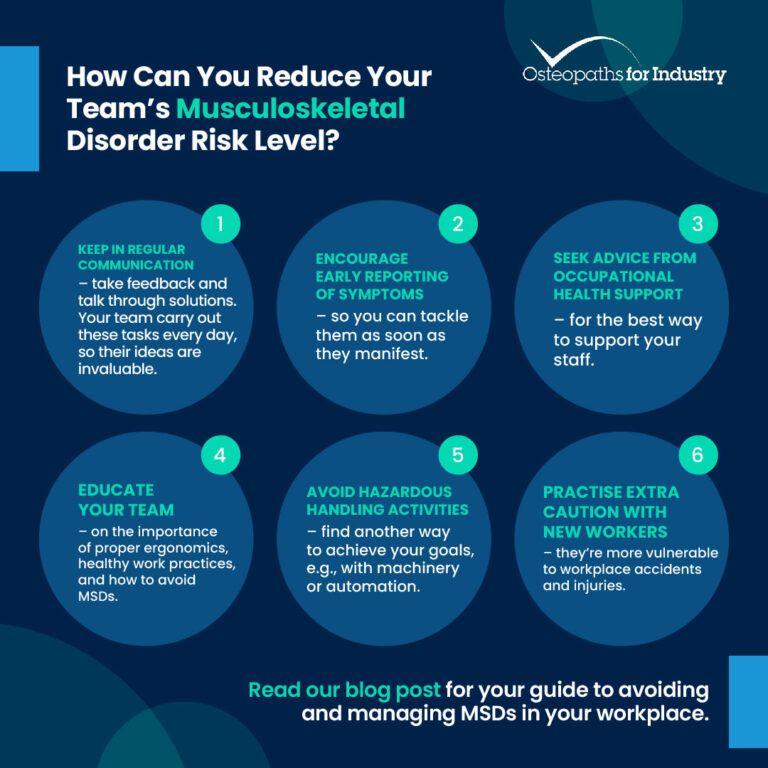Musculoskeletal disorders (MSDs) could pose a significant risk to the health and well-being of your employees, detrimentally affecting their ability to remain productive at work while also putting a strain on their lives outside the workplace. As an employer, your responsibility to protect your employees from the risks of developing or exacerbating MSDs is paramount to creating a safe, productive work environment. Even employees who work office jobs on a computer can suffer from unforeseen strain, injury, or mental fatigue that must be appropriately managed and prevented.
There are plenty of measures you can take to prevent and manage MSDs amongst your workforce. This should include covering risk assessments, what MSDs can be caused by, communicating with your workers regarding their musculoskeletal health, and taking the relevant legal considerations into account. By implementing these measures, you can ensure that your employees remain healthy, happy, and productive, cultivating a safer work environment for all.
Understanding MSDs and Identifying Risk Factors:
MSDs encompass a range of injuries and conditions affecting the back, joints, and limbs. The most commonly affected body parts include the lower back, shoulders, forearms, wrists, hands, neck, hips, legs, knees, ankles, and feet. It is crucial for employers to identify and manage the risk factors associated with MSDs, which can stem from various activities or working environments, including:
- Manual Handling: Tasks involving bending, crouching, stooping, and lifting, pushing, pulling, or dragging heavy loads. These tasks are the most common cause of MSDs and can result in injuries that affect both the professional and personal lives of your team.
- Repetitive Work and Awkward Postures: Jobs requiring repetitive actions, particularly with the same hand or arm, or involving sustained or excessive force, e.g., on a factory line or a construction site.
- Display Screen Equipment: Potential health and safety hazards associated with using display screen equipment (DSE), such as computer monitors, laptops, and other visual display units. Prolonged and improper use of DSE can lead to various health issues, including MSDs, eye fatigue, repetitive strain injuries, and even poor mental health.
- Vibration Exposure: Impacts of vibration on workers who engage in manual tasks involving vibrating tools or machinery in their jobs. Vibration exposure can affect the whole body or just the limbs, depending on the nature of the mechanisms involved. For example, driving mobile machinery over rough ground or using powered, hand-held tools continuously and for long periods at a time.
- Environmental and Organisational Factors: Poor working environments, including temperature and lighting, and poor work organisation, such as high work pressure and lack of breaks.
- Individual Worker Factors: Recent or existing injuries or health conditions, individual differences in vulnerability to specific risks, and belonging to vulnerable groups (e.g., mature, disabled, pregnant, or new workers.)
Managing the Risk:
To successfully manage the risk of MSDs in the workplace, employers should conduct both general risk assessments and specific assessments for tasks such as manual handling, repetitive work, and display screen equipment. Communication with workers is essential, as they can provide valuable insights into their work conditions and suggest improvements. Some key strategies include:
1. Consulting with your team
Regular communication with workers or their representatives about health and safety problems helps identify difficulties and potential for improvements. Your employees will be the best judges of what tasks they find difficult or strenuous and will often provide invaluable advice on how to improve these practices.
2. Encouraging your employees to report symptoms early
Making sure your team report any injuries or work-related health problems as soon as they manifest is essential. One way of doing this might involve body mapping. This is a valuable technique for collecting evidence about the effects of work on the body, allowing you to see via ‘body maps’ where employees’ symptoms are located.
3. Seeking advice from occupational health support
This can be helpful in assessing a worker’s fitness for work, recommending restrictions or adaptations, and organising and supporting rehabilitation.
4. Educating your teams
Ensuring workers are aware of the importance of reporting symptoms early and providing information on how to do so couldn’t be more important. This might include running workshops on proper ergonomics and healthy work practices. Also, be sure to encourage open communication between management and your workers to ensure a seamless transfer of feedback, allowing for continual improvements.
5. Avoiding hazardous manual handling
This involves identifying manual handling tasks that may be of high risk to a worker’s safety and nullifying these tasks. You can do this by finding another way to achieve the goals of the high-risk tasks that do not put any workers at risk or automating them by using machinery.
6. Be extra careful with new workers!
Recently hired staff are equally likely to have an accident in the workplace during the first 6 months on the job as they are for the remainder of their career. Facts like these highlight the importance of easing these workers into their roles, providing thorough training, and creating a work environment that prioritises their safety.

At OFI, we can provide manual handling, people moving and handling, and DSE-related risk assessments for your staff. Alternatively, we can also train members of your team to become your own in-house risk assessors. These types of injury prevention solutions are indispensable in preemptively identifying risk factors and stopping your staff from hurting themselves in the workplace. We provide expert, in-depth assessments on:
Legal Considerations:
There are various laws which govern the prevention of MSDs in the workplace. At OFI, we want to emphasise the importance of complying with these health and safety regulations.
It’s essential for employers to be aware of and adhere to these laws to ensure the well-being of their workforce.
So, what do the legal responsibilities of an employer include regarding work-related MSDs?
You must:
- Protect your employees’ health and safety and those impacted by their activities.
- Conduct regular risk assessments to identify MSD-related risks and ensure compliance with relevant regulations. Employers should focus on emphasising the avoidance and reduction of hazardous manual handling.
- Carry out workstation assessments, risk reduction, eye tests, and training for workers primarily working with display screen equipment.
- Provide necessary protection against vibration exposure, especially when long-term and/or associated with back pain and hand-arm vibration syndrome (HAVS).
Your employees have duties, too. They must:
- Adhere to the health and safety systems you put in place.
- Ensure that they correctly use any equipment provided for their health and safety.
- Cooperate with you on health and safety matters.
- Inform you if there is a change in the safety of the work environment or if they identify hazardous handling activities.
- Ensure that their activities do not put other employees at risk.
In Summary
It is important to note that different industries may face specific challenges regarding MSDs. As such, employers are advised to refer to industry-specific guidelines for detailed information on controlling MSDs in particular sectors, in addition to implementing the more general strategies outlined above. Workers in almost every industry sector are prone to some form of workplace musculoskeletal disorder, so make sure that you stay informed and vigilant regarding your employees’ well-being!
Effectively managing musculoskeletal disorders in the workplace requires a proactive approach that involves risk assessment, transparent and frequent communication with workers, and compliance with relevant laws. By prioritising the well-being of employees and implementing preventive measures, you can create a safer and healthier work environment, reducing the incidence of MSDs and promoting greater levels of employee satisfaction and productivity.








